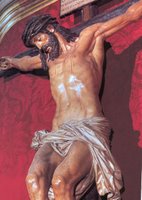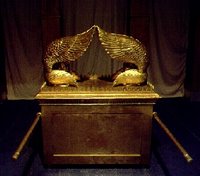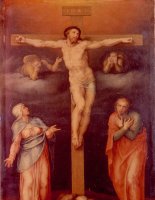Q: My Bible study group asks, “Why does the Catholic religion portray Jesus hanging on the cross while Protestant crosses are empty?”
 A: The answer is more complex than first appears. Lutherans, Episcopalians, and others also have or allow crucifixes. Churches in Eastern Orthodoxy will have painted images, but not sculpted. While some of this is connected with specific abuses, a major part stems from understanding of the Ten Commandments and the interpretation of the Mosaic Law in the lives of Christians.
A: The answer is more complex than first appears. Lutherans, Episcopalians, and others also have or allow crucifixes. Churches in Eastern Orthodoxy will have painted images, but not sculpted. While some of this is connected with specific abuses, a major part stems from understanding of the Ten Commandments and the interpretation of the Mosaic Law in the lives of Christians.God forbad Israel from making graven images of Him and then worshiping the images. Yet in Christ, God made an image of Himself in human form. Since that time, many believers are convinced that God allows a depiction of His incarnation [enfleshment] in crucifixes, paintings, and the like. Lutheran pastor and seminary professor Chad Bird captured this thought in his hymn The Infant Priest Was Holy Borne. Stanza 2 begins, “This great High Priest in human flesh Was icon of God’s righteousness.”
Dissenters cite prohibitions such as Exodus 20:4, “You shall not make for yourself a carved image, or any likeness of anything that is in heaven above, or that is in the earth beneath, or that is in the water under the earth.” God’s explanation of the prohibition could allow images, yet not allow worship. He continues in verse 5: “You shall not bow down to them or serve them.” The idea of “for yourself” can be taken to mean “for personal worship.”
 Furthermore, the Lord commanded the construction of images in Exodus 25:18-22. He ordered that two cherubim be carved and placed on the Mercy Seat of the Ark of the Covenant and described how He wanted them placed.
Furthermore, the Lord commanded the construction of images in Exodus 25:18-22. He ordered that two cherubim be carved and placed on the Mercy Seat of the Ark of the Covenant and described how He wanted them placed.Additionally, we must ask if those commands directed specifically to Israel also apply to Gentiles, or even to Jewish converts to Christianity? Other prohibitions, such as the dietary laws, are set aside, as when Peter had the vision of the “common” or “unclean” foods prior to receiving the messengers of the Cornelius (Acts 10). Paul specifically stated that the New Moon or Sabbath celebrations hold no special importance in the resurrection (Colossians 2:16) since all days are holy to God.
Many in Christendom consider images, including crucifixes, in the same light. Operating both under the freedom of the Gospel and as Gentiles who never lived under the Law given to Israel at Sinai, they believe themselves free to make such images as focuses of devotion and as reminders of the all-availing sacrifice of Christ upon the cross.
Martin Luther was one such person. In one breath in a 1522 sermon he said of images, “[T]hey ought to be abolished when they are worshipped [sic]; otherwise not, — although because of the abuses they give rise to, I wish they were everywhere abolished. (LW 51)” Taking this quote by itself, we might say that Luther had become an iconoclast (a destroyer of images).
However, as his understanding of Gospel and Scripture developed and matured, Luther spoke well of the proper use of images, including the crucifix. During his sermon series on John from the early 1530s, probably drawing on memories of his own days in the monastary, Luther remarked, “It was a good practice to hold a wooden crucifix before the eyes of the dying or to press it into their hands. This brought the suffering and death of Christ to mind and comforted the dying. (LW 23)”
 Numerous (but not all) Protestants believe and teach differently. They recognize no difference between images used to remind us of Christ or His saints and images of Christ or the saints that are worshiped. They believe that the Law given through Moses not only bound Israel, but also binds all subsequent believers in the true God, whether Israelite or Gentile. They may allow simple crosses, but not the crucifix with its “scandalous” image affixed. Some go so far as to ban all art, even simple crosses, from public worship and from believers’ private lives.
Numerous (but not all) Protestants believe and teach differently. They recognize no difference between images used to remind us of Christ or His saints and images of Christ or the saints that are worshiped. They believe that the Law given through Moses not only bound Israel, but also binds all subsequent believers in the true God, whether Israelite or Gentile. They may allow simple crosses, but not the crucifix with its “scandalous” image affixed. Some go so far as to ban all art, even simple crosses, from public worship and from believers’ private lives.Battles over images during the Reformation were not only between various reformers and Rome, but also among various factions of reformers. For instance, one of Luther’s early allies in the Reformation, Dr. Karlstadt, later started violently smashing images, dragging them out of churches and damaging the weak faith of some of the parishioners. Luther perceived this to be such a threat to the freedom of the Gospel that he left his hiding place, even though the emperor had declared him an outlaw, in order to preach against those who were destroying images, altars, and other trappings of the Church.
Eastern Orthodox churches also had disputes over images, including what was known as the Iconoclastic Controversy. Some argued for the destruction of all images while others encouraged their use for individual devotion and for corporate memory of Christ and the saints. Most of the 700s AD saw fighting over this issue. The Eastern Church finally settled on allowing painted, mosaic, or other “flat” images, but disallowed carved statuary and the like.
I favor the majority opinion of the Western Church, although I would not blindly use images under all circumstances. If they are abused by being worshiped or if they lead people to petition the saints rather than the Savior, then I would oppose them. However, if they are used under Christian freedom as devotional aids and reminders of God’s grace, then I think crucifixes and other images serve salutary purposes and should be allowed in the home and the church.
We cannot use potential for abuse as an excuse to make a blanket ban of anything. To do so rejects the freedom we have in Christ and, quite often, the gifts of Creation. While Luther in his 1522 sermon could say, “Now, although it is true and no one can deny that the images are evil because they are abused, nevertheless we must not on that account reject them, nor condemn anything because it is abused,” he pointed out that across the board rejection “would result in utter confusion. (LW 51)”
 Referring to Deuteronomy 4:19, which prohibits bowing down to “the sun and the moon and the stars,” Luther said, “There are many people who worship the sun and the stars. Therefore we propose to rush in and pull the sun and stars from the skies. No, we had better let it be.” Touching on the Apocrypha (Ecclesiasticus [Sirach] 19:2 and 31:30), he commented, “Wine and women bring many a man to misery and make a fool of him; so we kill all the women and pour out all the wine.” Dr. Luther went on to note that “gold and silver” must then also be abolished and that finally, “we shall have to kill ourselves, for we have no greater enemy than our own heart. (LW 51)”
Referring to Deuteronomy 4:19, which prohibits bowing down to “the sun and the moon and the stars,” Luther said, “There are many people who worship the sun and the stars. Therefore we propose to rush in and pull the sun and stars from the skies. No, we had better let it be.” Touching on the Apocrypha (Ecclesiasticus [Sirach] 19:2 and 31:30), he commented, “Wine and women bring many a man to misery and make a fool of him; so we kill all the women and pour out all the wine.” Dr. Luther went on to note that “gold and silver” must then also be abolished and that finally, “we shall have to kill ourselves, for we have no greater enemy than our own heart. (LW 51)”A sinful, misguided heart is the source of idolatry, regardless of the object. While some fools might truly believe in and worship a statue or a painting, the greater and more common folly is believing that by bringing images, art (or anything else of ourselves) into worship, we are somehow doing something special for God. We risk moving from Christ-worship to self-worship even more so when we label such memorials or make a show of their giving, as Lutheran blogger Caroline of Our Little House on the Prairie noted in I Must Confess.
 I leave you with the conclusion drawn by the Rev. Paul McCain (archived on his previous blog) this quote from Powerful Devotional Resource: “In short, and this is the most important point of all: there is nothing contrary to God’s Holy Word, or our Lutheran Confessions, about the proper use of the crucifix, just as there is nothing wrong with the proper use of an empty cross, or any other church symbol by which we are reminded of the great things God has done for us. We need to guard against quickly dismissing out of hand practices that we believe are ‘too Roman Catholic’ before we more adequately explore their use and history in our own church.
I leave you with the conclusion drawn by the Rev. Paul McCain (archived on his previous blog) this quote from Powerful Devotional Resource: “In short, and this is the most important point of all: there is nothing contrary to God’s Holy Word, or our Lutheran Confessions, about the proper use of the crucifix, just as there is nothing wrong with the proper use of an empty cross, or any other church symbol by which we are reminded of the great things God has done for us. We need to guard against quickly dismissing out of hand practices that we believe are ‘too Roman Catholic’ before we more adequately explore their use and history in our own church.“In Christian freedom, we use either the crucifix or an empty cross and should not judge or condemn one another for using either nor not using either symbol of our Lord’s sacrifice for our sins.”
Scripture quoted from The Holy Bible, English Standard Version™, © 2001 by Crossway Bibles.
Luther quotes marked LW 23 are from Luther’s Works, vol. 23: “Sermons on the Gospel of St. John: Chapters 6-8” (J. J. Pelikan, H. C. Oswald & H. T. Lehmann, Ed.). Luther’s Works. Saint Louis: Concordia Publishing House.
Luther quotes marked LW 51 are from Luther’s Works, vol. 51: “Sermons I” (J. J. Pelikan, H. C. Oswald & H. T. Lehmann, Ed.). Luther’s Works. Philadelphia: Fortress Press.
Send email to Ask the Pastor.
Walter Snyder is the pastor of Holy Cross Lutheran Church, Emma, Missouri and coauthor of the book What Do Lutherans Believe.
Technorati Tags: crucifix | graven images | icons | images | cross | art
Thanks, Walt. Nothing here I didn't already know, but it's all here in one place, thoroughly explained -- and with illustrations, no less. Excellent.
ReplyDeleteA good summary. What is strange is when Protestant groups attempt to explain their lack of crucifixes by skirting the real issue and pretending that it's because they (and not Catholics/Lutherans/etc??) believe in a resurrected Jesus, not one "still on the cross." This is nonsense. As has often been said elsewhere, this is a straw man-- the cross would have empty whether or not Jesus had risen from the dead. What may lurk under the fear of crucifixes, for some, is the horrible reality that Jesus really did die for our sins. We don't tend to like the reminder, and it's easier to just skip ahead to the happier season of Easter and ignore all that sin and dying talk. But we ignore the atonement to our own peril.
ReplyDeleteCrucifix or empty cross represents the pivot point regarding theology of glory versus theology of the cross. When I see a crucifix, it becomes all about Christ and crushes anything in me that may say it’s about me doing something for God. The crucifix says wholly, what saves you. Christ death saves, not his resurrection represented by the empty cross. His resurrection was the outcome of his sinless life and obedience in innocent suffering and death. I really see no risk of self coming forward in the crucifix. I agree wholeheartedly that icons of Mary and of past Saints do pose a much greater risk of deviating the Christian from Christ death to a reliance of man and self.
ReplyDelete"He was raised then for our justification..."
DeleteThe only thing I would add is the bronze snake that was lifted up by Moses to heal those who had been bitten by serpents in the desert. This was commanded by God and as such was a holy thing. It was only after Israel started worshiping it as an idol that it had to be destroyed. A very good lesson for us today.
ReplyDeleteAnother point, courtesy of Dr. Lowell Green, one of my college history professors (it should be said that I've discussed this with Pr. McCain, and he disputes it, though I'm not entirely sure on what ground).
ReplyDeleteIn the Middle Ages, the corpus on the cross was, among other things, a liturgical symbol of the Real Presence. In Germay, to this day, there is a strong tendency for Lutheran churches to use the crucifix, especially in areas in which the Reformed rather than Roman Catholicism is the most widespread
denominational rival.
That does not, of course, mean that to display an empty cross is to deny the Real Presence. But it does provide additional information about why the Reformed are inclined to avoid them.
I myself find it interesting that the more influenced a Lutheran community is by Pietism, the less popular the crucifix tends to be. I think it also speaks to the objectivity of what Christ accomplished for us and His dispensing of it through the objective Means of Grace in a very helpful way.
He says to worship Him in spirit and truth.There is no imagery in spirit and truth.Faith is belief in the unseen jealous true God.He jealous of idiots and that includes anything in the sky,earth,or under the sea.If He commands such things I'm stay as far a way of anything even near to this.Faith and obedience is all I need for salvation.
ReplyDeletePeter's dream had nothing to do with food. I'm disappointed that such a thing I'd pointed to at all. You need to read the whole chapter. When you use that to justify a point out of context, it discredits the whole article.
ReplyDelete